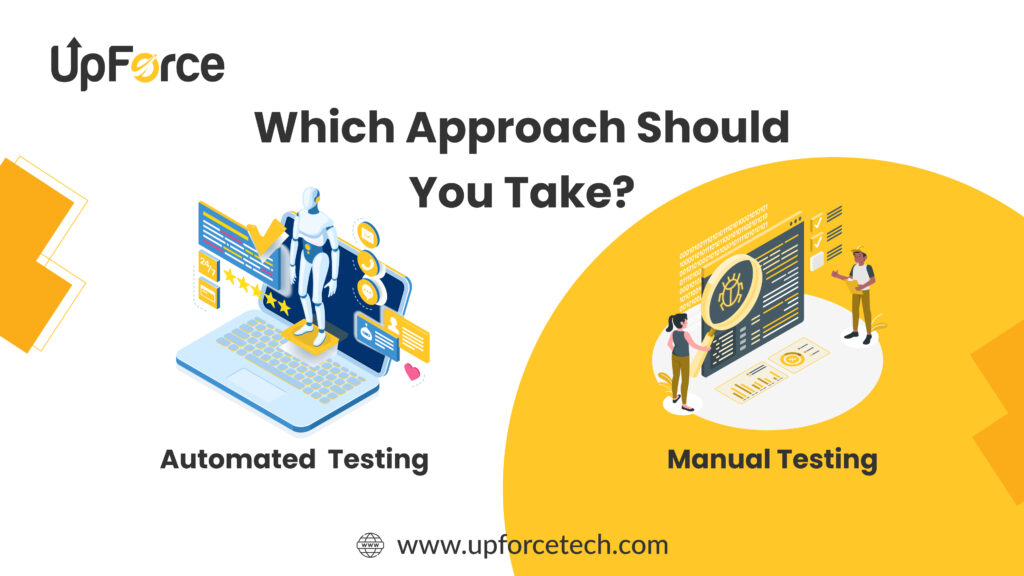Automated Testing vs. Manual Testing: Choosing the Right Approach for Your Project
Table of Contents
Automated Testing vs. Manual Testing
Software testing is an integral part of the development process, ensuring that applications run smoothly and meet user expectations. When it comes to testing methodologies, the two main approaches are automated testing and manual testing. Both have unique strengths and weaknesses, making it essential to understand which one suits your project needs best.
In this blog, we’ll dive into the key differences, advantages, and best use cases for automated and manual testing, helping you make an informed decision for your next project.

What is Automated Testing?
Automated testing uses tools and scripts to execute tests, compare actual outcomes to expected results, and report discrepancies. It is ideal for repetitive, time-intensive, or high-volume testing scenarios.
Key Features of Automated Testing
- Speed and Efficiency: Faster execution of repetitive tests.
- Reusability: Scripts can be reused across multiple projects.
- Coverage: Tests cover a wide range of scenarios.
- Tools: Popular tools include Selenium, Cypress, and JUnit.
What is Manual Testing?
Manual testing involves human testers who execute test cases without the use of automation tools. It is best suited for scenarios requiring human observation, such as UI/UX testing or exploratory testing.
Key Features of Manual Testing
- Human Insight: Effective for identifying user interface issues and aesthetic problems.
- Flexibility: Adaptable to changes without rewriting scripts.
- Tools: Testers use predefined test cases or ad-hoc methods to identify bugs.
Automated Testing vs. Manual Testing: A Comparative Analysis
| Aspect | Automated Testing | Manual Testing |
|---|---|---|
| Execution Speed | Faster execution for repetitive tests. | Slower, as it requires human intervention. |
| Cost | High initial cost for tools and script development. | Lower initial cost but higher over time. |
| Accuracy | Eliminates human errors in repetitive tasks. | Prone to errors due to manual effort. |
| Test Coverage | Covers extensive test cases and data-driven tests. | Limited by human capacity. |
| Scalability | Scales easily for large projects. | Difficult to scale for extensive testing. |
| Best For | Regression, performance, and repetitive testing. | UI/UX, exploratory, and ad-hoc testing. |
When to Use Automated Testing
- Frequent Code Changes: For agile environments requiring regular regression testing.
- Performance Testing: Assessing how applications perform under load.
- Repetitive Tasks: Scenarios like form validation or login/logout functionality.
- Extensive Test Cases: Projects involving large datasets or complex workflows.
Example
E-commerce Website Testing:
An e-commerce company used Selenium to automate the testing of their product search and checkout flows. Automation reduced testing time by 50% and improved accuracy in identifying edge cases.
When to Use Manual Testing
- Short-Term Projects: When the cost of automation isn’t justifiable.
- User Interface Testing: Observing design, aesthetics, and interactivity.
- Exploratory Testing: Identifying bugs without predefined test cases.
- Real-World Simulations: Testing features like GPS tracking or voice commands.
Example
Mobile App Testing:
A startup developing a fitness app relied on manual testing to refine the UI and improve the user experience based on tester feedback.
The Hybrid Approach: Combining Automated and Manual Testing
For many projects, combining both approaches yields the best results. Automated testing handles repetitive tasks, while manual testing focuses on creative and user-centric scenarios.
Best Practices for a Hybrid Testing Strategy
- Automate Repetitive Tasks: Use tools for regression and performance testing.
- Manual for Critical Areas: Focus manual efforts on UI/UX and exploratory testing.
- Continuous Integration (CI): Integrate automated tests into CI pipelines for efficiency.
Future Trends in Software Testing
- AI-Driven Testing: Automated tools leveraging AI for smarter test case generation.
- Codeless Testing: Simplifying automation with tools requiring no coding expertise.
- Shift-Left Testing: Testing earlier in the development cycle to reduce costs.
- Cloud Testing: Using cloud platforms for scalability and real-time collaboration.
2025 Trends in Software Testing
As technology advances, testing methodologies are evolving to meet new challenges:
1. AI-Driven Automated Testing
Artificial intelligence will play a significant role in automating complex test cases. AI-powered tools can adapt test scenarios dynamically, ensuring comprehensive coverage.
2. Shift-Left Testing
Testing will integrate earlier in the development cycle, enabling teams to identify bugs sooner and reduce costs.
3. Cloud-Based Testing
With remote work on the rise, cloud testing platforms will offer real-time collaboration, scalability, and cost efficiency.
4. Increased Adoption of Codeless Automation Tools
Codeless platforms will democratize automation testing, allowing non-technical testers to contribute effectively.
5. Focus on Cybersecurity Testing
With growing concerns over data breaches, automated and manual testing will include robust security checks.
How UpforceTech Can Help You Hire the Right Contract Developer
At UpforceTech, we specialize in connecting businesses with highly skilled contract developers who can meet their unique needs. Our rigorous vetting process ensures that you get access to the best talent, whether you need someone with expertise in front-end development, back-end systems, or mobile app development.
Here’s how UpforceTech can support your business:
- Access to a Global Talent Pool: We provide access to a diverse range of developers from around the world, ensuring you find the right fit for your specific project needs.
- Customized Hiring Solutions: Whether you’re looking for short-term contract developers or long-term project-based teams, we tailor our services to fit your requirements.
- Quality Assurance: Every developer in our network goes through a comprehensive screening process to ensure they have the necessary skills and experience to deliver high-quality work.
- Ongoing Support: Our commitment doesn’t end with hiring. We offer ongoing support to ensure a seamless integration of contract developers into your team.
For more information on how to get started with hiring contract developers, visit UpforceTech.
Are you looking to Grow your business with skilled developers? Hire a contract developer today to bring fresh ideas and expertise to your team. Learn how UpforceTech can help!
Sign up for the free Newsletter
"In the future of testing, automation ensures speed, while manual testing guarantees quality."
UpforceTech
FAQs
Automated testing offers faster execution, better accuracy, and broader test coverage for repetitive and large-scale tasks.
Choose manual testing for projects focusing on UI/UX, exploratory scenarios, or real-world simulations.
Yes, a hybrid approach leverages the strengths of both methods, ensuring thorough testing for your project.
Tools like Selenium, JUnit, and Cypress are widely used for automating test processes.
While it has a high initial cost, it reduces expenses in the long run for large or complex projects.
AI enhances automated testing by generating intelligent test cases and identifying anomalies faster.
Knowledge of programming languages, testing frameworks, and tools like Selenium or Appium is essential.
E-commerce, finance, and healthcare industries frequently use automated testing for performance and security checks.
Exploratory testing is an unscripted approach where testers explore the application to identify bugs creatively.
Automated testing is better suited for agile environments due to its speed and reusability.

